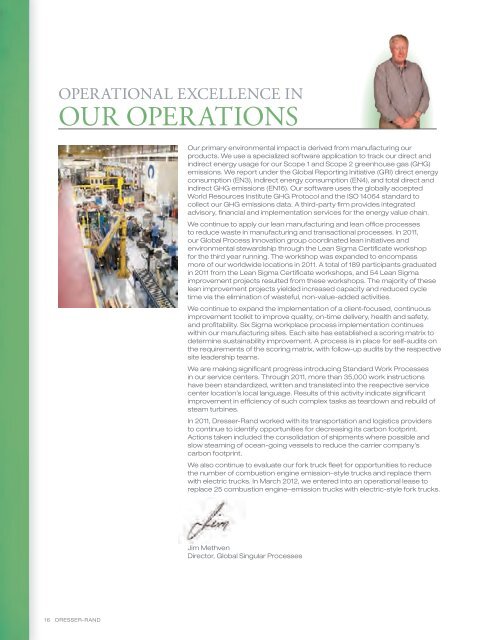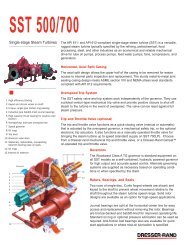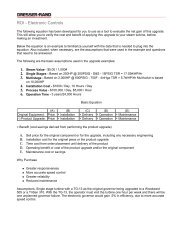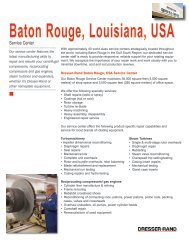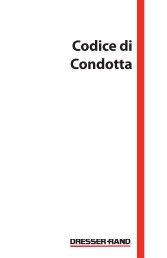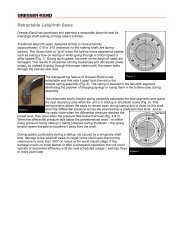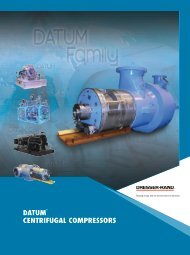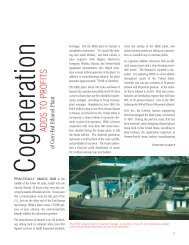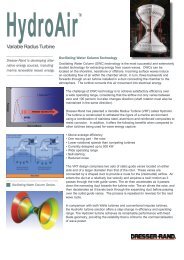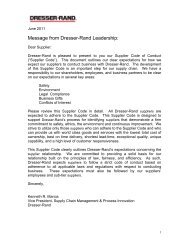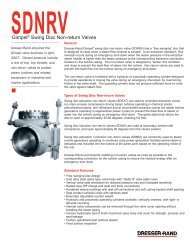case studies - Dresser-Rand
case studies - Dresser-Rand
case studies - Dresser-Rand
Create successful ePaper yourself
Turn your PDF publications into a flip-book with our unique Google optimized e-Paper software.
OPERATIONAL EXCELLENCE IN<br />
OUR OPERATIONS<br />
16 DRESSER-RAND<br />
Our primary environmental impact is derived from manufacturing our<br />
products. We use a specialized software application to track our direct and<br />
indirect energy usage for our Scope 1 and Scope 2 greenhouse gas (GHG)<br />
emissions. We report under the Global Reporting Initiative (GRI) direct energy<br />
consumption (EN3), indirect energy consumption (EN4), and total direct and<br />
indirect GHG emissions (EN16). Our software uses the globally accepted<br />
World Resources Institute GHG Protocol and the ISO 14064 standard to<br />
collect our GHG emissions data. A third-party firm provides integrated<br />
advisory, financial and implementation services for the energy value chain.<br />
We continue to apply our lean manufacturing and lean office processes<br />
to reduce waste in manufacturing and transactional processes. In 2011,<br />
our Global Process Innovation group coordinated lean initiatives and<br />
environmental stewardship through the Lean Sigma Certificate workshop<br />
for the third year running. The workshop was expanded to encompass<br />
more of our worldwide locations in 2011. A total of 189 participants graduated<br />
in 2011 from the Lean Sigma Certificate workshops, and 54 Lean Sigma<br />
improvement projects resulted from these workshops. The majority of these<br />
lean improvement projects yielded increased capacity and reduced cycle<br />
time via the elimination of wasteful, non-value-added activities.<br />
We continue to expand the implementation of a client-focused, continuous<br />
improvement toolkit to improve quality, on-time delivery, health and safety,<br />
and profitability. Six Sigma workplace process implementation continues<br />
within our manufacturing sites. Each site has established a scoring matrix to<br />
determine sustainability improvement. A process is in place for self-audits on<br />
the requirements of the scoring matrix, with follow-up audits by the respective<br />
site leadership teams.<br />
We are making significant progress introducing Standard Work Processes<br />
in our service centers. Through 2011, more than 35,000 work instructions<br />
have been standardized, written and translated into the respective service<br />
center location’s local language. Results of this activity indicate significant<br />
improvement in efficiency of such complex tasks as teardown and rebuild of<br />
steam turbines.<br />
In 2011, <strong>Dresser</strong>-<strong>Rand</strong> worked with its transportation and logistics providers<br />
to continue to identify opportunities for decreasing its carbon footprint.<br />
Actions taken included the consolidation of shipments where possible and<br />
slow steaming of ocean-going vessels to reduce the carrier company’s<br />
carbon footprint.<br />
We also continue to evaluate our fork truck fleet for opportunities to reduce<br />
the number of combustion engine emission–style trucks and replace them<br />
with electric trucks. In March 2012, we entered into an operational lease to<br />
replace 25 combustion engine–emission trucks with electric-style fork trucks.<br />
Jim Methven<br />
Director, Global Singular Processes


